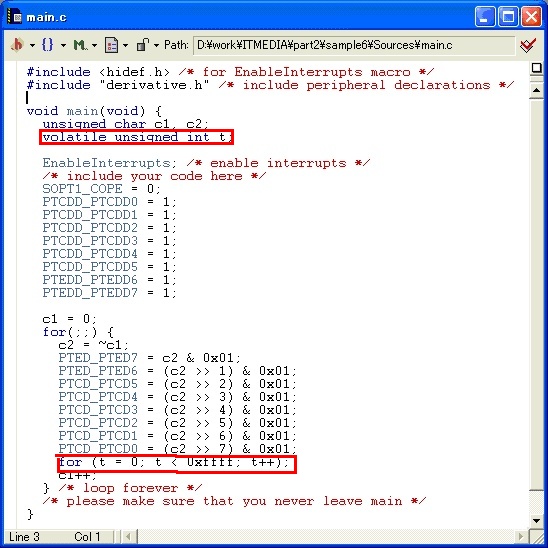汎用I/Oを使って、LEDを操ってみよう:S08ではじめるマイコン制御プログラミング(3)(3/3 ページ)
» 2008年11月27日 00時00分 公開
[高田浩,@IT MONOist]
プログラムの修正
それでは、ループの中に時間待ちの処理を入れてみます。
時間待ち処理で使われる変数tを定義する際、必ずvolatile指定子を使ってください。これは最適化を抑制するものです。これを忘れると、コンパイル時にtは未使用ということで処理が取り除かれてしまいます。
ちょっとmain関数が煩雑になってきました。処理ごとに関数に分けてみましょう(リスト5)。
#include <hidef.h> /* for EnableInterrupts macro */
#include "derivative.h" /* include peripheral declarations */
void mcu_init(void);
void putbyte_led(unsigned char);
void wait(unsigned int);
void main(void) {
unsigned char c;
EnableInterrupts; /* enable interrupts */
/* include your code here */
mcu_init();
c = 0;
for(;;) {
putbyte_led(c);
wait(0xffff);
c++;
} /* loop forever */
/* please make sure that you never leave main */
}
void mcu_init(void){
SOPT1_COPE = 0;
PTCDD_PTCDD0 = 1;
PTCDD_PTCDD1 = 1;
PTCDD_PTCDD2 = 1;
PTCDD_PTCDD3 = 1;
PTCDD_PTCDD4 = 1;
PTCDD_PTCDD5 = 1;
PTEDD_PTEDD6 = 1;
PTEDD_PTEDD7 = 1;
return ;
}
void putbyte_led(unsigned char c){
c = ~c;
PTED_PTED7 = c & 0x01;
PTED_PTED6 = (c >> 1) & 0x01;
PTCD_PTCD5 = (c >> 2) & 0x01;
PTCD_PTCD4 = (c >> 3) & 0x01;
PTCD_PTCD3 = (c >> 4) & 0x01;
PTCD_PTCD2 = (c >> 5) & 0x01;
PTCD_PTCD1 = (c >> 6) & 0x01;
PTCD_PTCD0 = (c >> 7) & 0x01;
return ;
}
void wait(unsigned int time){
volatile unsigned int c;
for (c = 0; c < time; c++) ;
return ;
}
リスト5
また、せっかくスイッチがいくつもありますから、カウンタの制御用に使ってみましょう。PTA2でアップ、PTA3でダウン、PTD2で停止です(リスト6)。
#include <hidef.h> /* for EnableInterrupts macro */
#include "derivative.h" /* include peripheral declarations */
void mcu_init(void);
void putbyte_led(unsigned char);
void wait(unsigned int);
void main(void) {
unsigned char c;
char step;
EnableInterrupts; /* enable interrupts */
/* include your code here */
mcu_init();
c = 0;
step = 0;
for(;;) {
if (!PTAD_PTAD2) {
step = 1;
} else if (!PTAD_PTAD3) {
step = -1;
} else if (!PTDD_PTDD2) {
step = 0;
}
putbyte_led(c);
wait(0xffff);
c += step;
} /* loop forever */
/* please make sure that you never leave main */
}
void mcu_init(void){
SOPT1_COPE = 0;
PTCDD_PTCDD0 = 1;
PTCDD_PTCDD1 = 1;
PTCDD_PTCDD2 = 1;
PTCDD_PTCDD3 = 1;
PTCDD_PTCDD4 = 1;
PTCDD_PTCDD5 = 1;
PTEDD_PTEDD6 = 1;
PTEDD_PTEDD7 = 1;
PTADD_PTADD2 = 0;
PTAPE_PTAPE2 = 1;
PTADD_PTADD3 = 0;
PTAPE_PTAPE3 = 1;
PTDDD_PTDDD2 = 0;
PTDPE_PTDPE2 = 1;
return ;
}
void putbyte_led(unsigned char c){
c = ~c;
PTED_PTED7 = c & 0x01;
PTED_PTED6 = (c >> 1) & 0x01;
PTCD_PTCD5 = (c >> 2) & 0x01;
PTCD_PTCD4 = (c >> 3) & 0x01;
PTCD_PTCD3 = (c >> 4) & 0x01;
PTCD_PTCD2 = (c >> 5) & 0x01;
PTCD_PTCD1 = (c >> 6) & 0x01;
PTCD_PTCD0 = (c >> 7) & 0x01;
return ;
}
void wait(unsigned int time){
volatile unsigned int c;
for (c = 0; c < time; c++) ;
return ;
}
リスト6
どうですか? これまでの実習でデモ・ボードのハードウェアを変更することなくソフトウェアの変更だけでいろいろな機能が実現できたことに着目してください。余裕のある人は、LEDのカウンタの速度を変えたり、点滅パターンを変えたりしてみるなど、いろいろ試してGPIOの操作に慣れてください。
いかがでしたか。いろいろ試したような気がしますが、今回も基本のGPIOだけ使ってLEDを制御しました。次回は、制御に時間の概念を入れてみます。マイコン制御プログラムの世界がさらに広がりますよ。第4回をお楽しみに!(次回に続く)
Copyright © ITmedia, Inc. All Rights Reserved.
Special ContentsPR
特別協賛PR
スポンサーからのお知らせPR
Special ContentsPR
Pickup ContentsPR
組み込み開発の記事ランキング
- 忘年会に最適!? 使い捨てライターで離れた場所にあるLEDを点灯するガジェット
- ArmベースCPUと最大45TOPSのNPUを搭載する小型AIモジュールを発表
- 「日本の製造業が再び勝つために」、富士通が進める次世代国産CPUとAI戦略
- 「TRONプログラミングコンテスト2025」はRTOSとAIの融合に挑戦、審査結果を発表
- 三菱電機の独自フィジカルAI、予防保全で学習データを9割削減し精度を3割向上
- 進化を続けるパナの“画竜点睛”の通信規格Nessum 通信インフラとして需要が拡大
- 「Nintendo Switch 2」に採用されたexFATファイルシステム
- イチから全部作ってみよう(27)「ACID」で示されるデータベースの4つの特性
- Rapidusが半導体回路の設計期間を半減する支援ツールを投入、一部は無償提供へ
- ヒューマノイドを「人材派遣」へ、GMOはエンジニア帯同で現場の即戦力化を狙う
Special SitePR
コーナーリンク
よく読まれている編集記者コラム
あなたにおすすめの記事PR
 リスト4
リスト4

